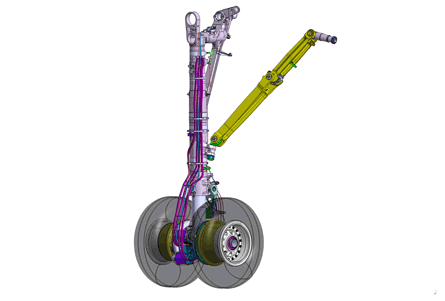Messier-Bugatti plans to demonstrate its "green taxiing" concept by the end of 2012 and says it is in discussions with Airbus about including the system on the proposed A320 New Engine Option programme.
Unlike rival designs that would use an electric motor mounted on the aircraft's nose gear, Safran group company Messier-Bugatti has decided to mount the motors on the main landing gear because "roughly 90% of the aircraft's weight is on the mains", says Safran equipment division executive vice-president Yves Leclère.
He says a "fully mature" version of the system could enter testing by late 2014 and be available for the A320 and Boeing 737 families by 2016.
"It's more interesting for short-range aircraft, but our intention is to have applications on all existing programmes and all new products, even to retrofit some existing programmes," says Leclère.
 |
|---|
© Messier Bugatti |
Short-haul aircraft typically perform more than 10 flights a day and so spend a much greater proportion of their service lives taxiing on the ground compared with long-haul aircraft.
Airbus and Boeing are "interested, and of course we have a strong interaction with them", says Leclère, who adds that discussions are also under way with "key airlines". Installation of the system would require some modifications to the airframe and well as the landing gear.
The motors would be mounted on the main landing gear bogies and draw electrical power from the auxiliary power unit, enabling aircraft to taxi without their main engines running. For the longer term, Messier-Bugatti is studying whether the landing gear motors could be powered by electrical energy recovered during the landing roll.
Safran says engines such as the CFM International CFM56 - which equips 737s and some A320s - burn around 12kg (5.4lb) of fuel a minute during the taxiing phase.
Although the green taxiing system will add "several hundred kilogrammes" to the weight of the airframe, this will be offset by the fact that the aircraft will carry less fuel, says Leclère. He says the fuel burn reduction will be "several percent" for a typical flight, which translates into savings of "several hundred thousand dollars per aircraft" every year.
 |
|---|
© Stephane de Bourgies/Abaca Press |
Another advantage is that carbon brake wear is reduced because the taxi-out can be conducted "more smoothly" than under main engine power when the brake pads are cold before take-off, which "changes the business model for brakes", says Leclère. The engines would also be less susceptible to foreign object damage on the ground.
"Our concept will have a very significant effect for the pushback, because you don't have to use an external vehicle, so that's a key element for the business model," says Leclère.
- All the latest news, video and images from the 2010 Farnborough air show - New this year, live streaming video of each day's flying display
Source: Flight International
















